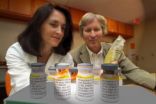(Press-News.org) In work suggesting a new approach to treating polycystic kidney disease (PKD), a leading cause of kidney failure, researchers at Children's Hospital Boston were able to block the formation of fluid-filled cysts, the hallmark of the disease, in a mouse model. Their findings, using a compound that inhibits a receptor known as c-Met, will be published in the September 13th online edition of the Journal of Clinical Investigation.
PKD is the most common fatal genetic disease affecting Caucasians in the U.S. Currently, there is no approved treatment to halt cyst growth, which causes a gradual but relentless loss of kidney function. Patients must often go on chronic dialysis by mid-adulthood or wait for a kidney transplant.
"This study gives us a new therapeutic target in PKD," says Jordan Kreidberg, PhD, in Children's Division of Nephrology, the study's senior investigator. "If we can get more supportive data in mice, it may provide the basis for a clinical trial in humans."
Hopes were raised when animal models showed promise in drugs inhibiting mTOR, a protein that coordinates cell growth and proliferation and has been shown to be hyper-activated in the disease. However, the reasons for this hyper-activation aren't well understood, and much-anticipated clinical trials of mTOR inhibitors, published August 26 in the New England Journal of Medicine, showed little or no effect on cyst growth, in part because toxicity limited their dosing.
The new study, led by Kreidberg and first author Shan Qin, MD, PhD, took a closer look at the molecular pathways, and showed that mTOR hyper-activation results from unwanted activity of c-Met, the receptor for hepatocyte growth factor.
Kreidberg and Qin used a mouse model for PKD created by collaborators at Brigham and Women's Hospital, in which the PKD1 gene (mutated in 85 percent of PKD patients) is deleted. When they blocked c-Met activity in mouse embryonic kidneys, using a small molecule called 448101 Met Kinase Inhibitor, also known as SU11274 (Calbiochem, La Jolla, Calif.), cyst formation was reduced to the level seen in normal kidneys.
They then gave the compound to pregnant mice carrying embryos that lacked PKD1. The kidneys of those embryos had a markedly reduced size and number of cysts as compared with untreated embryos.
"Recent studies on the biology of cyst formation have offered the hope for possible treatments that can either prevent or retard progression of cysts in patients with CKD, but the first clinical trial did not work," says William Harmon, MD, director of Pediatric Nephrology at Children's. "Dr. Kreidberg's discoveries are very promising in suggesting exciting new approaches to treating a very serious disease."
Kreidberg hopes these discoveries, if replicated in adult mice, will lead to clinical testing of c-Met inhibitors in patients with PKD. He suggests that these drugs could potentially be combined with mTOR inhibitors, as well as drugs targeting other PKD pathways under study.
"PKD is quite complex, with several regulatory pathways involved, and multiple places to target with therapy," he says. "It will likely benefit from sub-toxic doses of multiple agents, similar to cancer chemotherapy."
c-Met inhibitors are more specific and limited in their action than mTOR inhibitors, so may be less toxic, Kreidberg adds. "There are many ongoing cancer trials with c-Met inhibitors, so there's going be increasing information on their safety and pharmacology that might help us translate this to a treatment for PKD."
Aside from its role in cancer, c-Met is essential for embryonic development and wound healing. Normally, after it's been activated, it is tagged for degradation. But Kreidberg and colleagues show that in PKD, c-Met is never tagged, because the molecule that does the tagging get trapped inside a structure in the cell known as the Golgi apparatus.
The findings are consistent with the observation of excess amounts of c-Met in the cells lining the kidney cysts of PKD patients. "c-Met is probably part of a development pathway that's turned on again, sometime in early or mid-adulthood," says Kreidberg.
Polycystic kidney disease, the fourth leading cause of kidney failure, affects more than 700,000 people in the U.S., far surpassing other genetic disorders such as cystic fibrosis and sickle-cell disease.
###
The study was funded by the National Institute of Diabetes and Digestive and Kidney Diseases (NIDDK) of the National Institutes of Health.
Children's Hospital Boston is home to the world's largest research enterprise based at a pediatric medical center, where its discoveries have benefited both children and adults since 1869. More than 1,100 scientists, including nine members of the National Academy of Sciences, 12 members of the Institute of Medicine and 13 members of the Howard Hughes Medical Institute comprise Children's research community. Founded as a 20-bed hospital for children, Children's Hospital Boston today is a 392-bed comprehensive center for pediatric and adolescent health care grounded in the values of excellence in patient care and sensitivity to the complex needs and diversity of children and families. Children's also is the primary pediatric teaching affiliate of Harvard Medical School. For more information about the hospital and its research visit: www.childrenshospital.org/newsroom.
END
Cognitive scientists from the University of Rochester have discovered that playing action video games trains people to make the right decisions faster. The researchers found that video game players develop a heightened sensitivity to what is going on around them, and this benefit doesn't just make them better at playing video games, but improves a wide variety of general skills that can help with everyday activities like multitasking, driving, reading small print, keeping track of friends in a crowd, and navigating around town.
In an upcoming study in the journal Current ...
(New York, NY) Nearly half the surgeons who made at least $1 million in payments from orthopedic device companies did not have that relationship published in their scientific articles, according to a study released today in the on-line edition of the Archives of Internal Medicine. The study shows that readers are not being adequately informed about conflicts of interest even when the funds involved are significant.
The study, conducted by researchers at the New York-based Institute on Medicine as a Profession (IMAP), is the first of its kind to use company records ...
New York (September 13, 2010) - According to a new study a protein crucial for the immune response appears to be a key player in the progression of a devastating form of childhood leukemia called T-cell acute lymphoblastic leukemia (T-ALL). Suppressing the activity of the protein kills the leukemic cells, the study shows, opening a potential avenue to new drugs that could prevent progression of the disease.
Led by Iannis Aifantis, PhD, associate professor of pathology and director of the Cancer Stem Cell Program at the NYU Cancer Institute at NYU Langone Medical Center, ...
DALLAS – Sept. 13, 2010 – A tiny molecule that spurs the progression of non-small-cell lung cancer could become a player in fighting the disease, say researchers at UT Southwestern Medical Center, who published a study on how the molecule behaves in mice in the Sept. 14 issue of Cancer Cell.
Scientists have known that the molecule microRNA-21, or miR-21, is present in overabundant quantities in human tumors, including non-small-cell lung cancer (NSCLC). Until now, however, it was unclear whether miR-21 contributed to the development of lung cancer, or whether it was simply ...
DAVIS--A research team from the University of California, Davis and Peking University, China, has discovered a novel mechanism as to why the long-term, high-dosage use of the well-known arthritis pain medication, Vioxx, led to heart attacks and strokes. Their groundbreaking research may pave the way for a safer drug for millions of arthritis patients who suffer acute and chronic pain.
Using metabolomic profiling to analyze murine (rodent) plasma, the scientists discovered that Vioxx causes a dramatic increase in a regulatory lipid that could be a major contributor to ...
A study led by researchers at the BC Centre for Excellence in HIV/AIDS (BC-CfE) at St. Paul's Hospital and the University of British Columbia has found that supervised injection facilities such as Vancouver's Insite connect clients with addiction treatment, which in turn resulted in greater likelihood of stopping injection drug use for at least six months.
The study, recently published in the peer-reviewed journal Drug and Alcohol Dependence, is the first ever to examine the link between a supervised injection facility and injection cessation.
"Extensive research has ...
Researchers funded by the Biotechnology and Biological Sciences Research Council
(BBSRC) have discovered key plant enzymes that normally make the energy stored in wood, straw, and other non-edible parts of plants difficult to extract. The findings, published today in Proceedings of the National Academy of Sciences, can be used to improve the viability of sustainable biofuels that do not adversely affect the food chain.
The team based at the University of Cambridge, and now part of the BBSRC Sustainable Bioenergy Centre (BSBEC), has identified and studied the genes for ...
An antibiotic appears to be a safe treatment for stroke and a good companion therapy for tPA, the clot buster that is currently the only FDA-approved drug therapy, researchers report.
A safety study in 60 stroke patients in Georgia, Kentucky and Oregon found the drug well tolerated even at three-and-one-half times the dose currently used for conditions such as rheumatoid arthritis, according to a research team led by the Medical College of Georgia and the University of Georgia.
"It's cheap, safe, well tolerated, easy to administer and can be given with tPA," said Dr. ...
The theory holds that one of the best ways to attract foreign capital consists in the adoption of a reduced level of taxes in certain cases, and above all, in the provision of legal certainty. This aim of attracting foreign investment inspired the measures for the the Entidades Tenedoras de Valores Extranjeros (ETVE) or Spanish holding companies, adopted in Spain in the late 1990's and which led to the establishment of these companies in Spain by multinational companies. However, things are changing, according the head of the UC3M Research Group of Taxation and Finance ...
Mom's advice about cleaning your hands may finally be starting to get through.
In the latest observational study sponsored by the American Society for Microbiology and the American Cleaning Institute® (formerly The Soap and Detergent Association), 85% of adults washed their hands in public restrooms, compared with 77% in 2007. The 85% total was actually the highest observed since these studies began in 1996. The results were announced at the Interscience Conference on Antimicrobial Agents and Chemotherapy, an infectious disease meeting sponsored by the American Society ...


